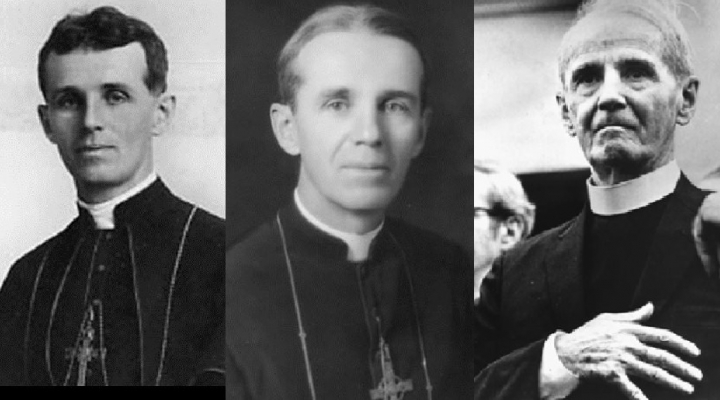
Who is Bishop Walsh?
Bishop James Edward Walsh:
The Pillar of Truth
''The task of a missionary is to go to a place where he is not wanted but needed, and to remain until he is not needed but wanted.'' - Bishop James E. Walsh
Bishop James Edward Walsh was born in Cumberland, Maryland on April 30, 1891. He graduated from Mount St. Mary’s College in Emmitsburg, Maryland at the age of 19. James worked two years as timekeeper in a steel mill. He entered the first class of the Maryknoll order of priests in 1912 at Maryknoll, New York. On December 7, 1915, he became the second priest ordained in the Society. Three years after he became a priest, he was assigned as a missionary to the people of China. In 1919, he became Superior of the Maryknoll Mission in China. Pope Pius XI named Father Walsh, at age 36, as the first bishop of the Vicariate of Kongmoon in 1927.
Just before the outbreak of World War II, Bishop Walsh was asked to be a mediator between the United States and Japan. He delivered messages from the Prime Minister of Japan to President Franklin Roosevelt. Unfortunately, his work was unsuccessful. The Japanese bombed the United States at Pearl Harbor, Hawaii on December 7, 1941.
Bishop Walsh returned to Maryknoll, New York in 1936. He was elected the second Superior General of Maryknoll, supervising Maryknoll’s first mission efforts to Latin America and Africa.
After World War II, Bishop Walsh returned to China at the Vatican’s request. In 1949, China became a Communist country. All of the temples and churches were closed. All of the priests were pressured to leave the country. Bishop Walsh loved the Chinese people and refused to abandon them. He was arrested by Communist officials on October 18, 1959 and sentenced to twenty years in prison.
The bishop served twelve years of this sentence. During all of those years, he was kept in solitary confinement. When he was interviewed later, Bishop Walsh refused to utter a harsh word against his captors. He was not allowed to have his rosary to pray, so he used his fingers to count the decades of the Rosary. In all of that time, he was allowed to have only one visitor, his brother William, former Maryland State Attorney General, in 1960.
After he became very ill, the Communists decided to release Bishop Walsh. He walked across Hong Kong’s Lo Wu Bridge to freedom on July 10, 1970. He was a hero and role model to the many Chinese who became converts to the Catholic faith due to his example of Christ-like love and compassion. They referred to him as “Wha Lee Son,” which means “Pillar of Truth.”
Due to his poor health, Bishop Walsh returned to the United States. Bishop Walsh stopped in Rome where he was received in an emotional audience by Pope Paul VI. In October of 1970, he came back to his hometown of Cumberland to celebrate Mass at the school named in his honor. Brother Lawrence Colhocker, the school principal at the time, said “Bishop Walsh is the embodiment of the values that form the philosophy of our school. His refusal to abandon his beloved Chinese people during a time of great crisis is an example of the kind of commitment and fidelity needed in our world today.”
When asked by the students of Bishop Walsh School if he would say something in Chinese to them, the Bishop responded, “Tin Gee Po Yau.” This means “May the Lord of Heaven protect and guard you.”
A prolific writer, Bishop Walsh wrote six books and many articles on mission life and work.
Bishop Walsh died at Maryknoll, New York on July 29, 1981. He was ninety years old.
